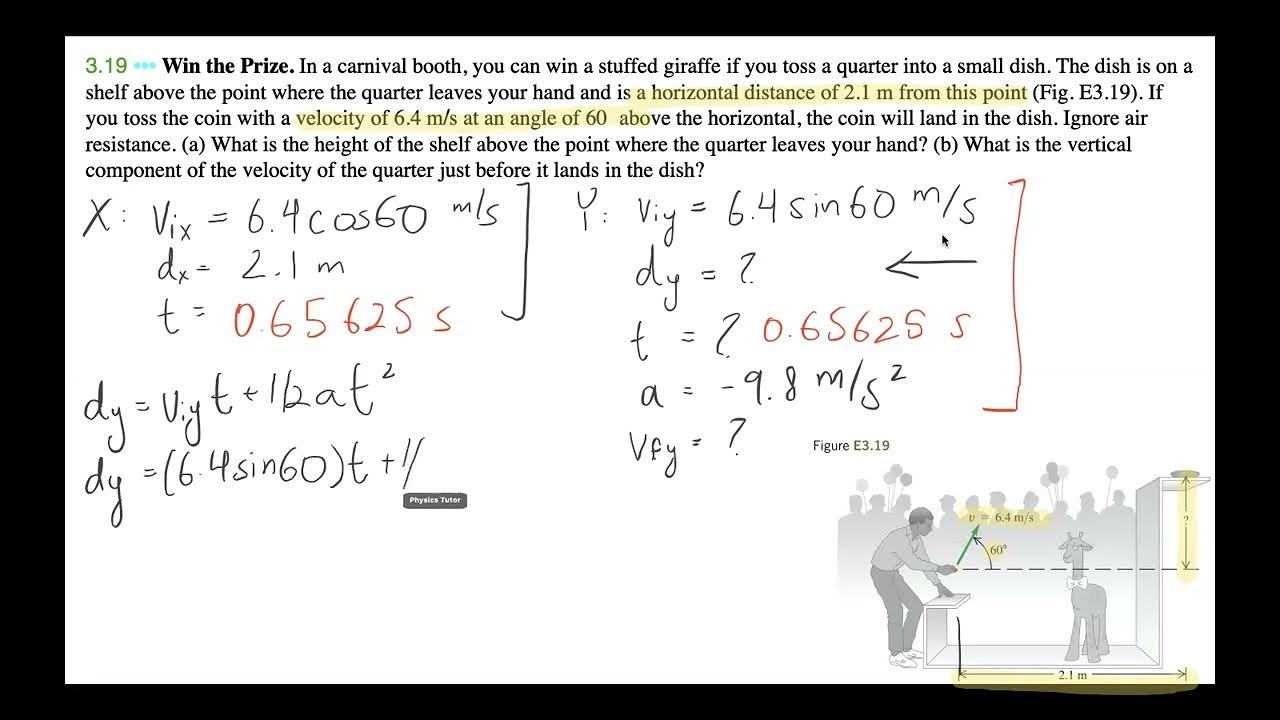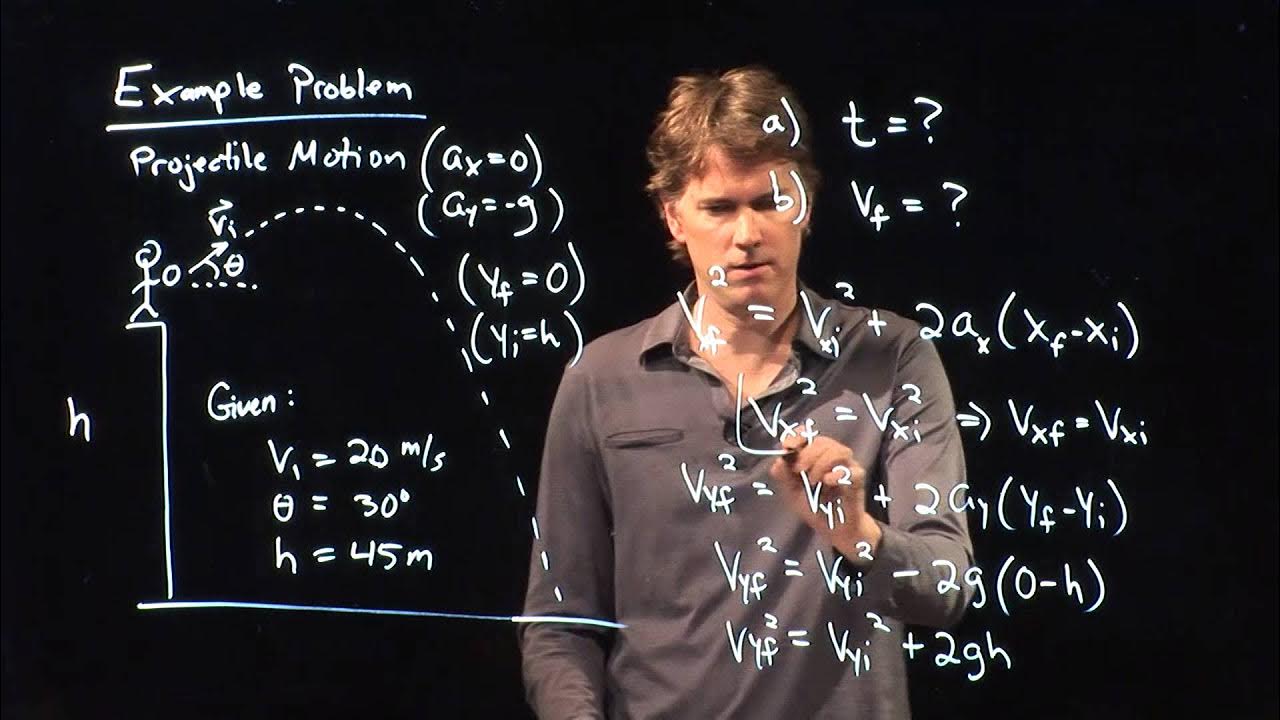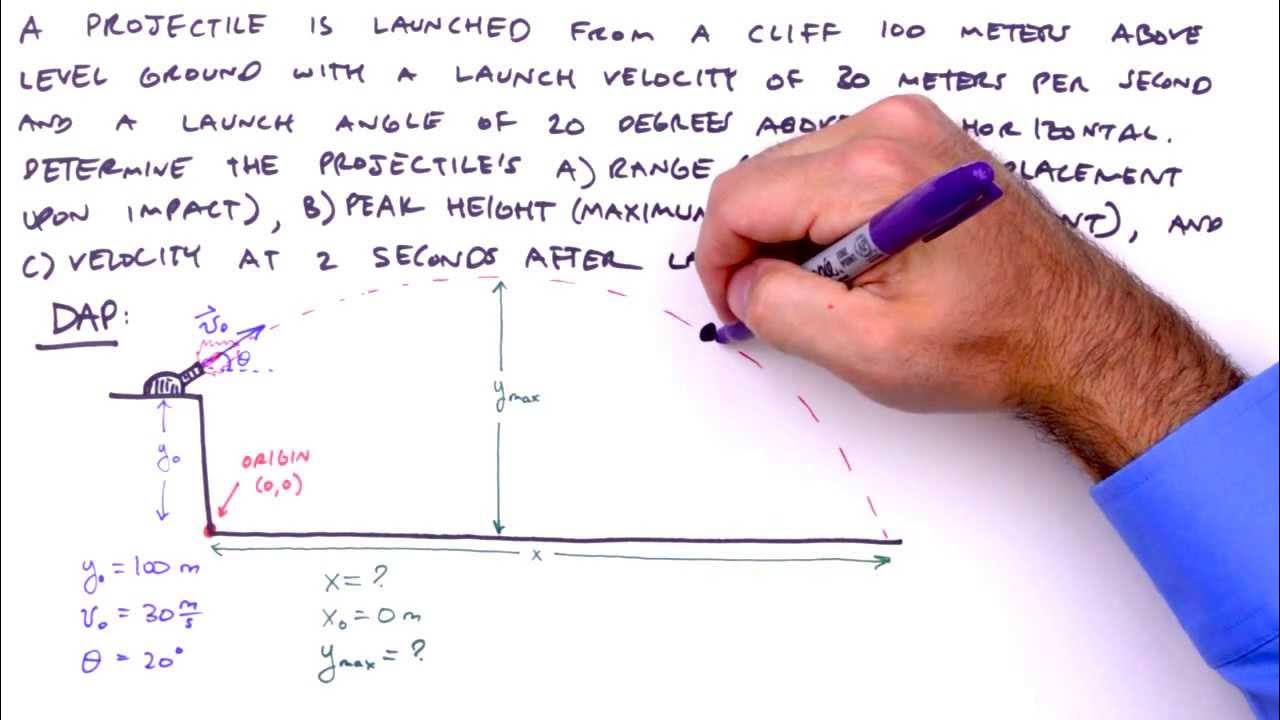University Physics Leaping the River II Problem
TLDRIn this educational video, the host tackles problem 3.63 from Young and Friedman's 'University Physics' textbook, which involves a physics professor attempting a daring motorcycle leap across a river. The problem requires calculating the necessary launch speed to clear a 40-meter-wide river with a 15-meter drop and no air resistance. The host methodically solves for the speed and time using kinematic equations, finding a required speed of 17.83 meters per second. In part B, they explore the outcome if the speed was halved, revealing the motorcycle would land in the water 28.4 meters from the start. The explanation is clear, engaging, and provides a step-by-step guide for solving projectile motion problems.
Takeaways
- 🛵 The problem involves a physics professor attempting a motorcycle jump across a river.
- 📚 The problem is from Young and Friedman's 'University Physics' textbook, specifically problem 3.63.
- 🔢 The takeoff ramp is inclined at 53 degrees, the river is 40 meters wide, and the far bank is 15 meters lower than the ramp.
- 🌉 The river is 100 meters below the ramp, and air resistance is ignored in the calculations.
- 🎯 Part A asks for the speed required at the top of the ramp to just make it to the edge of the far bank.
- 🔍 The problem is approached by considering both the horizontal (x) and vertical (y) components of motion.
- ⏱️ Time is an unknown variable in both the x and y directions, and the problem uses kinematic equations to solve for it.
- 📐 The solution involves setting up two equations based on the horizontal and vertical motion and solving them simultaneously.
- 🔢 For part A, the calculated speed required is 17.83 meters per second at a 53-degree angle above the horizontal.
- 📉 In part B, if the speed is only half of what was calculated in part A, the professor would land in the water.
- 📍 The distance from the starting point where the professor would land, with half the speed, is 28.4 meters into the river.
Q & A
What is the context of the physics problem discussed in the video?
-The video discusses a physics problem from Young and Friedman's 'University Physics' textbook, involving a professor attempting to jump across a river on a motorcycle. The problem involves calculating the required speed to make it to the other side and where the professor would land if the speed was half of the required speed.
What are the key dimensions mentioned in the problem related to the ramp and the river?
-The key dimensions are: the takeoff ramp is inclined at 53 degrees, the river is 40 meters wide, the far bank is 15 meters lower than the top of the ramp, and the river itself is 100 meters below the ramp.
What assumptions are made in the problem regarding air resistance?
-The problem assumes that air resistance is negligible and can be ignored.
What are the two parts of the problem discussed in the video?
-Part A asks for the speed the professor should have at the top of the ramp to just make it to the edge of the far bank. Part B asks where he would land if his speed was only half the value found in Part A.
What is the initial speed (v_i) calculated for Part A of the problem?
-The calculated initial speed for Part A is 17.83 meters per second.
What is the time (T) the professor would be in the air if he had the calculated speed?
-The time the professor would be in the air with the calculated speed is 3.277 seconds.
If the professor's speed was half of the required speed, what would be his new speed?
-If the professor's speed was half of the required speed, his new speed would be 8.9156 meters per second.
How far would the professor land from the starting point if his speed was half of the required speed?
-If the professor's speed was half of the required speed, he would land 28.4 meters from his starting point.
What method does the video recommend for solving the equations with two unknowns?
-The video recommends using substitution as the preferred method for solving the equations with two unknowns.
What is the significance of the angle 53 degrees in the problem?
-The angle of 53 degrees is the inclination of the takeoff ramp, which affects the horizontal (vix) and vertical (viy) components of the initial velocity, and thus the trajectory of the motorcycle's jump.
How does the video approach the problem of finding where the professor would land if his speed was insufficient?
-The video uses the kinematic equations for motion under constant acceleration (gravity) to find the time of flight and then calculates the horizontal distance traveled during that time.
Outlines
🔍 Physics Problem Introduction
The video script introduces a physics problem from Young and Friedman's 'University Physics' textbook, specifically problem 3.63. The problem involves a physics professor attempting a motorcycle jump across a river. The setup includes a ramp inclined at 53 degrees, a river 40 meters wide, and a landing bank 15 meters lower than the ramp's top. The river is 100 meters below the ramp. The challenge is to calculate the speed needed at the top of the ramp to just make it to the far bank, ignoring air resistance. The script then outlines the known variables and the approach to solving the problem, which involves a two-dimensional analysis with separate considerations for the X and Y directions.
📚 Applying Kinematic Equations
The script delves into the application of kinematic equations to solve for the unknowns in the problem. It identifies the need for two equations due to the two unknowns: the initial speed (VI) and the time (T) of flight. The X-direction is considered first, using the equation VIx = VI cos 53, with the distance (DX) being 40 meters and time (T) as an unknown. For the Y-direction, the script uses the kinematic equation dY = VIy * T + 0.5 * a * T^2, with dY as -15 meters (the height difference), acceleration (a) as -9.8 m/s^2, and VIy as VI sin 53. The script then proceeds to set up these equations for solving using substitution, aiming to find the required initial speed.
🔧 Solving for Initial Speed and Time
The script continues by solving the equations derived from the kinematic analysis. It isolates time (T) using the X-direction equation and then substitutes this expression into the Y-direction equation to find a single equation in terms of the initial speed (VI). After simplifying, the script finds that the initial speed required to just make it to the far bank is 17.83 meters per second. It then calculates the time of flight (T) using the found speed, resulting in approximately 3.277 seconds. This part of the script provides the solution to part A of the problem.
🚴♂️ Calculating the Landing Point at Half Speed
For part B of the problem, the script considers what happens if the initial speed is only half of what was calculated in part A. It sets the new initial speed (VIb) to 8.9156 meters per second and recalculates the time of flight using the Y-direction equation with the new speed. The script finds two potential times, rejecting the negative value as it's not physically meaningful. It then uses the positive time value to calculate the horizontal distance traveled in the X-direction. The script concludes that at half the speed, the motorcycle would land 28.4 meters from the starting point, which would be in the water, thus failing to reach the far bank.
Mindmap
Keywords
💡Problem 3.63
💡Takeoff ramp
💡River
💡Velocity
💡Inclined angle
💡Projectile motion
💡Kinematic equations
💡Acceleration due to gravity
💡Substitution method
💡Horizontal distance
💡Time of flight
Highlights
The problem involves a physics professor attempting a motorcycle leap across a river.
The takeoff ramp is inclined at 53 degrees.
The river is 40 meters wide and the far bank is 15 meters lower than the ramp.
The river is 100 meters below the ramp, ignoring air resistance.
Part A asks for the required speed at the top of the ramp to just make it to the far bank.
A two-dimensional problem is presented with knowns in the X and Y directions.
The X direction involves initial speed, distance, and time with no acceleration.
The Y direction includes acceleration due to gravity, affecting the speed equation.
The problem requires setting up a coordinate system with positive X and Y directions.
Two equations are generated for the X and Y directions with two unknowns: initial speed and time.
The solution involves substituting the time equation from the X direction into the Y direction equation.
The calculation simplifies to isolating the initial speed squared and solving for the speed.
The required speed to just make it to the far bank is found to be 17.83 meters per second.
Part B considers a scenario where the speed is half of the value found in Part A.
With half the speed, the professor would land in the water 28.4 meters from the starting point.
The solution process involves kinematic equations and solving quadratic equations.
The video concludes with a summary of the problem's solution and an invitation for feedback.
Transcripts
Browse More Related Video

Man Throws Rock Projectile Motion Problem

Uniform Circular Motion, Example #2 stone whirled in circle

Projectile launched off a cliff at an angle

Win the Prize Projectile Motion Problem

Projectile Motion Example - How fast when it hits the ground

How To Solve Any Projectile Motion Problem (The Toolbox Method)
5.0 / 5 (0 votes)
Thanks for rating: